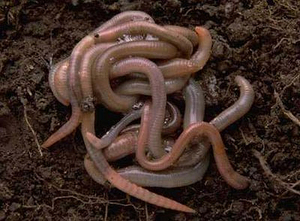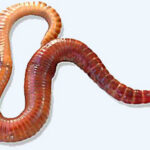Raising nightcrawlers isn’t difficult but there’s more to it than just dumping them in a bed and waiting. Earthworms require certain living conditions to keep them alive and healthy and to grow to maturity so they will reproduce. The worm wrangler must be vigilant, and maintain ideal feeding, soil conditions, and moisture levels to successfully raise nightcrawlers.
It is vital that the soil in the bed is kept loose and moist so that the nightcrawlers can wriggle and tunnel around without difficulty. Our bed is a combination of peat moss/top soil mix and coconut coir. So far, the bedding is still wonderfully loose and retains moisture beautifully. If the top of the soil is allowed to dry out, your nightcrawlers won’t come up to feed. No eating means no growth and no baby worms!
The soil should be moist but not waterlogged. Grab a handful of soil and give it a squeeze. You want a drop or two of water to come out. More than that, the soil is too wet and your worms might attempt an escape from the bed. Less than a drop or two, the soil is too dry and the worms will lose their protective slime coating. Don’t use the water hose to soak down the bed if it’s too dry! You might get carried away and drown the livestock. A misting bottle or sprinkling can works great to dampen down the soil.
Don’t feed your nightcrawlers for the first two or three days after you place them in their new home, so they have a chance to get acclimated to the new environment. Keep a bright light on them during this time to convince them to tunnel in and stay put.
You can feed your nightcrawlers all the same stuff that you would put in a compost pile: fruit and vegetable peelings, coffee and tea grounds, stale bread, shredded paper (no colored ink), and the like. Avoid putting much dairy or meat in the bedding, which can cause it to go sour. Add some calcium-rich greens to make your worms especially nutritious if you are raising them to feed to pets or farm animals. Some worm farmers will feed high-protein chicken mash to their nightcrawlers. Use the finest mash available, not the “crumblies,” and just sprinkle it on top of the bedding.
Under feeding is better than over feeding where nightcrawlers are concerned. Too much decaying food will poison the bedding with acid. For this reason, some worm growing sources say to feed the worms on the same end of the bedding each time, to give the worms a place to escape to if the food sours the bed.
Don’t mix the food in the bedding. Bury the food an inch or two below the surface and let the worms come up to get it. Misting the food with a little water helps the worms to consume it more easily. You don’t need to grind up the food; that’s the worms’ job!
You can feed your worms daily, or once or twice a week, depending on your schedule. Don’t add more food until the previous feeding has been consumed. If you are going to be away from home for a month or longer, you will need someone to come in and feed the nightcrawlers for you.
The pH balance of the soil is also critical. You will need a pH meter or chemical testing kit that can be found at most garden stores. The optimum pH for your worm bed is between 6.0 and 7.0. Keep the pH level stable by sprinkling some powdered limestone over the top of the bedding every two or three weeks. The limestone will also add calcium to your worm bed.
The ideal temperature for worm growth is between 60 and 70 degrees F, although worms will tolerate a wider range depending on the species. European Nightcrawlers can tolerate temperatures as low as 40 but African Nightcrawlers may die if temperatures drop below 60. Both can tolerate temperatures as high as 90 degrees F.
In northern climates, a heated basement or garage is the ideal spot for your worm bed. If you are raising several beds, you may need a greenhouse-type setup. If your worm farm is in a cool area, you can increase the temperature by carefully suspending a light bulb a few inches above the bed. In parts of the South, where temperatures don’t drop below the minimum in the evening, you’re all set to raise worms outdoors. Put the beds in a shady spot during the daytime to keep them from overheating in extremely hot weather.
Turn the bedding (gently!) every two or three weeks to aerate the soil and so you can see how your worms are doing, but don’t turn while there is still food in the bedding! If your earthworms are dying, and the moisture, temperature, and ph levels are adequate, that probably means that the bedding has turned sour. The only thing you can do at this point is to immediately put the worms into fresh, clean bedding.
Worms who are unhappy in their bedding may try to crawl out. You might find your worms in a big pile on the floor some morning. Adding a light source will help keep the worms in their place! Worms are sensitive to light and will tunnel under the soil to get away from it. At night, a street light or night light is sufficient. Worm wranglers who take care to maintain the right soil conditions shouldn’t have a big problem with the livestock trying to make a getaway.
With careful attention to your worm beds, your nightcrawlers will soon begin laying egg capsules, which can hold as many as two dozen baby worms each. You will usually find them near the food source. Just take good care of your worm bed and before long you will be blessed with many little baby worms!
After about six months, check the size of your worms. To harvest your worms, dump the contents of your worm bed onto a large tarp in a cone-shaped pile. A large bed will be easier to harvest if you transfer some of the bedding and worms to a five-gallon bucket and do that amount at one time. Shine a bright light on top of the pile and the worms will tunnel their way into the center to escape the light. Carefully sweep the soil off the top of the pile, and as the worms keep working their way into the bottom center, keep removing the top. Eventually you will be left with a wriggling mass of worms.
Pick out the larger worms to sell or use as fish bait, or food for pet reptiles and birds. Store the adult nightcrawlers in small containers with some sphagnum moss, and keep the containers in a cool place.
There are a couple of options concerning the young worms and the old bedding. The soil will be rich with organic nutrients, worm casings, and egg capsules. You may have been so happy with the success of your worm farm that you want to expand production. In that case, put the old bedding back in the bed, and before long the egg capsules will hatch and start a new generation of worms. Prepare a new bed for the young worms that you harvested, and introduce them to their new home. Get the new bed ready before harvesting, so the young livestock can move right in. You’ve just doubled the size of your farm!
Another option, if you don’t have room or the desire for more than one bed, is to put the young worms back in the same bed. You can prepare fresh bedding or dump the old bedding back into the worm bed. Don’t forget that your worms have created a rich mulch for you! Using the old bedding for mulch will add vital nutrients that your plants need. The egg capsules will hatch, and the resulting worms will aerate and improve your garden soil. If you don’t garden, maybe you have some gardening friends who would appreciate having this excellent mulch.
Then congratulate yourself on the small part you have done to keep from adding garbage to the landfill, taking care of precious lives (even if they are only worms), and creating a wonderful mulch to feed the earth and plants with!








